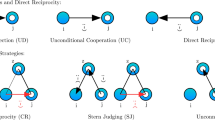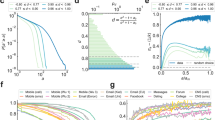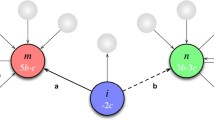Abstract
Many models of social network formation implicitly assume that network properties are static in steady-state. In contrast, actual social networks are highly dynamic: allegiances and collaborations expire and may or may not be renewed at a later date. Moreover, empirical studies show that human social networks are dynamic at the individual level but static at the global level: individuals’ degree rankings change considerably over time, whereas network-level metrics such as network diameter and clustering coefficient are relatively stable. There have been some attempts to explain these properties of empirical social networks using agent-based models in which agents play social dilemma games with their immediate neighbours, but can also manipulate their network connections to strategic advantage. However, such models cannot straightforwardly account for reciprocal behaviour based on reputation scores (“indirect reciprocity”), which is known to play an important role in many economic interactions. In order to account for indirect reciprocity, we model the network in a bottom-up fashion: the network emerges from the low-level interactions between agents. By so doing we are able to simultaneously account for the effect of both direct reciprocity (e.g. “tit-for-tat”) as well as indirect reciprocity (helping strangers in order to increase one’s reputation). This leads to a strategic equilibrium in the frequencies with which strategies are adopted in the population as a whole, but intermittent cycling over different strategies at the level of individual agents, which in turn gives rise to social networks which are dynamic at the individual level but stable at the network level.
Similar content being viewed by others
References
Axelrod R. (1997) The complexity of cooperation: Agent-based models of competition and collaboration. Princeton University Press, Princeton, NJ
Baird R. W., Dill L. M. (1996) Ecological and social determinants of group size in transient killer whales. Behavorial Ecology 7(4): 408–416
Bolton G. E., Katok E., Ockenfels A. (2004) How effective are electronic reputation mechanisms? An empirical investigation. Management Science 50(11): 1587–1602
Bowles S., Gintis H. (2004) The evolution of strong reciprocity: Cooperation in heterogenous populations. Theoretical Population Biology 65: 17–28
Boyd R., Richerson P. J. (1988) The evolution of reciprocity in sizable groups. Journal of Theoretical Biology 132: 337–356
Cremer J., Melbinger A., Frey E. (2012) Growth dynamics and the evolution of cooperation in microbial populations. Scientific Reports 2: 281
Do A.-L., Rudolf L., Gross T. (2010) Patterns of cooperation: Fairness and coordination in networks of interacting agents. New Journal of Physics 12(6): 063023
Eldredge, N., & Gould, S. J. (1972). Punctuated equilibria: An alternative to phyletic gradualism. In Schopf TJM editor models in paleobiology (pp. 82–115). San Francisco: Cooper & Co.
Erev I., Roth A. E. (1998) Predicting how people play games: Reinforcement learning in experimental games with unique, mixed strategy equilibria. American Economic Review 88(4): 848–881
Fehr E., Gächter S. (2000) Fairness and retaliation: The economics of reciprocity. Journal of Economic Perspectives 14(3): 159–181
Flache A., Macy M. W. (2002) Stochastic collusion and the power law of learning: A general reinforcement learning model of cooperation. The Journal of Conflict Resolution 46(5): 629–653
Goncalves B., Perra N., Vespignani A. (2011) Validation of Dunbar’s number in Twitter conversations. PLoS ONE 6(8): e22656
Granovetter M. (1985) Economic action and social structure: The problem of embeddedness. American Journal of Sociology 91(3): 481–510
Izquierdo S. S., Izquierdo L. R., Gotts N. M. (2008) Reinforcement learning dynamics in social dilemmas. Journal of Artificial Societies and Social Simulation 11(2): 1
Kaisers, M., & Tuyls, K. (2010). Frequency adjusted multi-agent Q-learning. In W. van der Hoek, G.A. Kaminka, Yves Lespérance, M. Luck, & S. Sen (Eds.), Proceedings of the 9th international conference on autonomous agents and multiagent systems (pp. 309–316). International Foundation for Autonomous Agents and Multiagent Systems.
Kossinets G., Watts D. J. (2006) Empirical analysis of an evolving social network. Science 311(5757): 88–90
Leimar, O., & Hammerstein, P. (2001). Evolution of cooperation through indirect reciprocity. Proceedings. Biological sciences/The Royal Society, 268(1468):745–753, Apr. 2001.
Matsumoto M., Nishimura T. (1998) Mersenne Twister: A 623-dimensionally equidistributed uniform pseudo-random number generator. ACM Transactions on Modeling and Computer Simulation 8(1): 3–30
Milinski M., Semmann D., Bakker T. C., Krambeck H. J. (2001) Cooperation through indirect reciprocity: Image scoring or standing strategy?. Proceedings of the Royal Society of London. Series B: Biological Sciences 268(1484): 2495–2501
Nowak A., Sigmund K. (2005) Evolution of indirect reciprocity. Nature 437: 1291–1298
Nowak M., Sigmund K. (1998) Evolution of indirect reciprocity by image scoring. Nature 383: 537–577
Nowak M. A., Sigmund K. (1994) The alternating prisoner’s dilemma. Journal of Theoretical Biology 168: 219–226
Ohtsuki H., Hauert C., Lieberman E., Nowak M. A. (2006) A simple rule for the evolution of cooperation on graphs and social networks. Nature 441(7092): 502–505
Packer C., Scheel D., Pusey A. E. (1990) Why lions form groups: Food is not enough. American Naturalist 136(1): 1–19
Phelps, S. Binaries and source-code for reciprocity model. http://jabm.sourceforge.net. Online; Accessed 14/12/2011.
Phelps, S. (2012). Applying dependency injection to agent-based modeling: The JABM toolkit. Technical Report WP056-12, Centre for Computational Finance and Economic Agents (CCFEA).
Phelps, S., Nevarez, G., & Howes, A. (2009). The effect of group size and frequency of encounter on the evolution of cooperation. In LNCS, Volume 5778, ECAL 2009, advances in artificial life: Darwin meets Von Neumann (pp. 37–44) Budapest: Springer.
Poncela J., Gómez-Gardeñes J, Floría L. M., Sánchez A., Moreno Y. (2008) Complex cooperative networks from evolutionary preferential attachment. PLoS ONE 3(6): e2449
Richerson, P. J., & Boyd, R. (1998). The evolution of human ultra-sociality. In: Eibl-Eibisfeldt, I., & Salter, F. (Eds.), Idealogy, warfare and indoctrinability (pp. 71–95). Berhan Books.
Roberts G., Sherratt T. N. (1998) Development of cooperative relationships through increasing investment. Nature 394: 175–179
Russell Y. I., Call J., Dunbar R. I. M. (2008) Image scoring in great apes. Behavioural Processes 78: 108–111
Santos F., Rodrigues J., Pacheco J. (2006) Graph topology plays a determinant role in the evolution of cooperation. Proceedings of the Royal Society B: Biological Sciences 273(1582): 51–55
Santos F. C., Pacheco J. M., Lenaerts T. (2006) Cooperation prevails when individuals adjust their social ties. PLoS Computational Biology 2(10): 1284–1291
Saramäki, J., Kivelä, M., Onnela, J. P., Kaski, K., & Kertész, J. (2007). Generalizations of the clustering coefficient to weighted complex networks. Physical Review E, 75(2).
Smith J. M., Szathmáry E. (1995) The major transitions in evolution. Oxford University Press, Oxford
Spearman C. (1904) The proof and measurement of association between two things. American Journal of Psychology 15(1): 72–101
Sutton R. S., Barto A. G. (1998) Reinforcement learning: An introduction. MIT Press, Cambridge, MA
Vught, M. V., Roberts, M., & Hardy, C. (2007). Competitive altruism: Development of reputation-based cooperation in groups. In Handbook of evolutionary psychology (Chap. 36). Oxford University Press.
Watkins J. C. H., Dayan P. (1992) Q-learning. Machine Learning 8: 279–292
Wedekind C., Milinski M. (1996) Human cooperation in the simultaneous and alternating prisoner’s dilemma: Pavlov verses generous tit-for-tat. Proceedings of the National Academy of Science USA 93: 2686–2689
Zimmermann M. G., Eguíluz V. M., Miguel M. S., Spadaro A. (2000) Cooperation in an adaptive network. Advances in Complex Systems 3(1–4): 283–297
Author information
Authors and Affiliations
Corresponding author
Electronic Supplementary Material
The Below is the Electronic Supplementary Material.
Rights and permissions
About this article
Cite this article
Phelps, S. Emergence of social networks via direct and indirect reciprocity. Auton Agent Multi-Agent Syst 27, 355–374 (2013). https://doi.org/10.1007/s10458-012-9207-8
Published:
Issue Date:
DOI: https://doi.org/10.1007/s10458-012-9207-8




